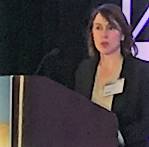NEW YORK—Cyberattacks and data security need to be high priorities for all businesses, experts stressed at ALM’s cyberSecure 2017 event here, Dec. 4 and 5. In fact, not only is failing to prepare for an attack or breach risky, it’s foolish, Kathleen McGee, internet & technology bureau chief for the Office of the Attorney General of the State of New York said in Monday’s opening address. She added that not reporting a breach in a timely fashion has its own set of legal and reputational risks, referring to the SHIELD Act (the Stop Hacks and Improve Electronic Data Security Act), introduced to New York State legislature by Attorney General Eric Schneiderman in November.
5. In fact, not only is failing to prepare for an attack or breach risky, it’s foolish, Kathleen McGee, internet & technology bureau chief for the Office of the Attorney General of the State of New York said in Monday’s opening address. She added that not reporting a breach in a timely fashion has its own set of legal and reputational risks, referring to the SHIELD Act (the Stop Hacks and Improve Electronic Data Security Act), introduced to New York State legislature by Attorney General Eric Schneiderman in November.
“Under the SHIELD Act, companies would have a legal responsibility to adopt reasonable, administrative, physical and technical safeguards for sensitive data,” she said Monday, adding that the standards would apply to any business holding data of New Yorkers, whether or not they do business in the state.
McGee noted that even though a company may not have all the details in the first 72 hours following a breach, reporting it to the New York Department of Financial Services (NYDFS) or another regulator is crucial. It is a legal requirement as part of the NYDFS Cybersecurity Requirements for Financial Services Companies, and even if all the pertinent information about an attack is not yet available, divulging what is known will prevent further enforcement action from the state.
“For some companies, data is the only commodity,” she said. “But in the past 10 years, risk assessments have not evolved as quickly as data collection.”
That observation lent itself to a segue for the next session, “Integrating Periodic Risk Assessment to Avoid Becoming the Next Target of a High-Profile Cyberattack.” Panelists covered the importance of formal risk assessments, which will be legally required by regulators like the NYDFS and the General Data Protection Regulation (GDPR) in Europe and goes into effect in 2018.
Moderator Eric Hodge, director of consulting at CyberScout, said education charts the path to a positive assessment and suggested using non-traditional training methods to onboard clients and employees over the course of a year.
“There are a lot of ways to educate other than the traditional annual training session set in a typical conference room,” Hodge said. “You can try white hat phishing to trap people in a safe way. Share your stories every month and be honest about your own failures. There are ways beyond just checking a box.”
eHarmony Vice President and General Counsel Ronald Sarian said his company has learned from its past incidents to better prepare and to update its ERM framework. The dating and compatibility company’s site was breached in 2012, before he joined the group.
“You need to do a data impact assessment and ask: What are your family jewels?” noted Sarian, who said he aims to implement ISO27001 as the ERM framework to secure eHarmony’s international and cyber presence. “We had so much in place already that I thought we should take a shot at it. It takes at least a year but so far it’s working for us.”
When considering ransomware, experts from healthcare, insurance and electronic payments companies spoke passionately during a dedicated session about how they mitigate risks. Christopher Frenz, director of infrastructure at the Interfaith Medical Center strongly advocated for network segmentation, which he uses at the center, in an effort to keep intrusions contained.
As previously reported, Advisen’s recent Information Security and Cyber Risk Management Survey indicated that, for the first time in the seven years of the survey, there has been a decline in how seriously C-Suite executives view cyberrisk. With that trend in mind, panelist Christopher Pierson, Ph.D., chief security officer & general counsel of ViewPost, a provider of electronic invoice and payment services to businesses, outlined his approach to eliciting a response from board members.
“You can’t tell the board that [paying] is not an option unless it’s illegal,” Pierson said. “Educate the board and explain that it is an option to pay terrorists and criminal syndicates. You’ll see the looks on their faces and then you’ll get them [to want to take action].”
For more information about GDPR, read Risk Management magazine’s coverage.

 Just as Santa Claus brings gifts down chimneys, his name alone also carries the stigma of risks that transcend all industries. Indeed, thanks to the logistics of his job we better understand the risks of
Just as Santa Claus brings gifts down chimneys, his name alone also carries the stigma of risks that transcend all industries. Indeed, thanks to the logistics of his job we better understand the risks of  Theresa Morzello, the managing director for asset services for CBRE in New York City, has advised many companies who stay open or host events coinciding with parades and holidays. She said the first steps in mitigating disruption involve communicating with the event organizers and disseminating that information to tenants.
Theresa Morzello, the managing director for asset services for CBRE in New York City, has advised many companies who stay open or host events coinciding with parades and holidays. She said the first steps in mitigating disruption involve communicating with the event organizers and disseminating that information to tenants.